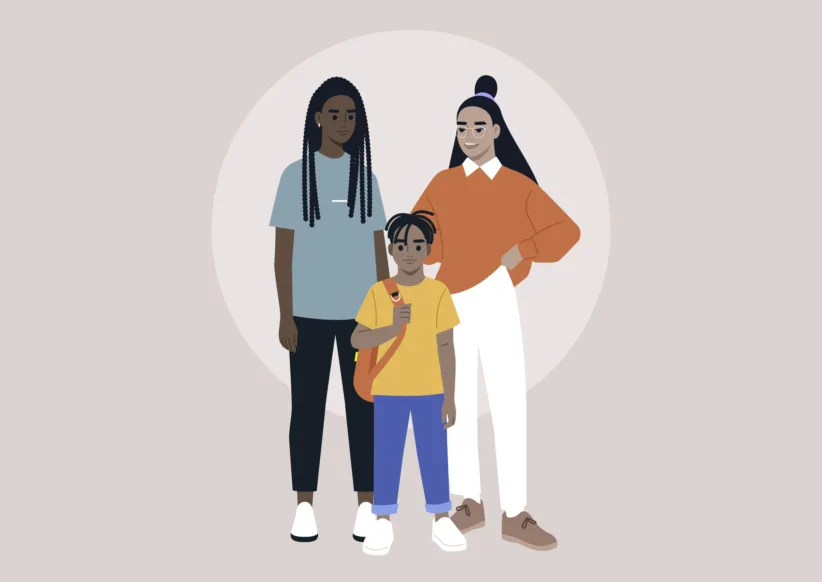Many museums in New York City are making efforts to not only attract families with children, but to also engage them. For instance, the Metropolitan Museum of Art has family guides available to use when exploring the space, and the Museum of Modern Art offers art cards as well as a space dedicated to hands-on learning for children and families. I recently visited the New York Historical Society, also home to the DiMenna Children’s Museum, to view the Annie Leibovitz exhibition, “Pilgrimage.” It was a pleasant surprise to see that the exhibit had a family guide available so that my child could be engaged as we walked through the gallery space. I spoke to Alice Stevenson, director of the DiMenna Children’s History Museum, about the addition of a family guide for an exhibit like “Pilgrimage.”
Shnieka Johnson: What is the family guide?
Alice Stevenson: “The Annie Leibovitz: Pilgrimage Family Guide” is a way for kids and grown-ups to explore the exhibition together — to look closely, to discuss, to form opinions, and to learn something new. It first encourages families to look closely at Leibovitz’s work in order to appreciate the composition, the mood, the objects, and to ponder her intentions; and second it layers in historical information about the places, events, and people related to the photographs. The history she is representing is so dense, we wanted to make sure kids walked away from the exhibition with a deeper understanding of these important figures in American history.
SJ: What types of activities are included?
AS: We selected 10 photographs from the exhibition and for each image we have two pages. One page has “Look” questions directing families to notice details in the photographs. The second page has “Learn” text layering in relevant historical information and hopefully some surprising facts. We wanted Annie Leibovitz’s photographs to speak for themselves, and then we wanted the historical figures to “speak” to the families. After all, these are all portraits of people, in their own way.
For example, at first, families won’t be aware they are looking at Abraham Lincoln’s top hat. We start by asking them to notice things like the wear on the hat, or where someone would wear a hat like this. Once families have looked closely at the hat itself, we then introduce Lincoln, and share that it was worn the night of his assassination.
Tops hats are associated with Lincoln in general, but this object is so specific to this momentous night in our history.
SJ: Why was it important to draw families to this particular exhibit?
AS: The New-York Historical Society is committed to engaging families in all of our exhibitions, in addition to the DiMenna Children’s History Museum. We do this in a variety of ways — through performing arts classes related to Chinese American: Exclusion-Inclusion, or a scavenger hunt that brings families through our permanent collection, or our Reading into History book club looking at documents in our library.
One of the things I love about “Pilgrimage” is that the photographs are a personal exploration of Leibovitz’s interest in history. We encourage kids to connect with and wonder about the people in American history, and their struggles and triumphs. By connecting with stories, kids can both more deeply understand the past and perhaps gain perspective on their own lives as New Yorkers.
SJ: Did the photographer have a preference for which images were used in the guide?
AS: No, we were able to chose from her works on view.
SJ: How does the guide help the family flow through the exhibit?
AS: Museum visitors sometimes come in to exhibitions with the expectation that they have to see every object. As an adult that can be tiring, but as a kid it can be exhausting.
Family guides and programs help this by highlighting a few objects around a theme, or suggesting a mode of looking.
We hope that families visit all the photographs in this guide, and then if they have an appetite for more they will keep exploring. I always encourage grown-ups to stop at a handful of objects, and then see where their interest takes them.
SJ: What is the suggested age range for the guide?
AS: 6 and up.
SJ: Why this and not an audio tour?
AS: We have done audio tours for families in the past — this summer we had one for “Madeline in New York: The Art of Ludwig Bemelmans.”
For this guide we chose a written piece because we really wanted to encourage contemplation of the works, and that is a very subjective experience. I might think looking for two minutes is enough, someone else might want to look for five minutes.
An audio guide felt too one-size-fits-all for what we wanted to accomplish with this guide.
SJ: Are there upcoming family programming or family-friendly events related to this exhibit?
AS: In addition to the family guide, our Little New-Yorkers program will hold a storytelling project in the gallery.
Annie Leibovitz “Pilgrimage” exhibit closes Feb. 22. DiMenna Children’s Museum at the New York Historical Society [170 Central Park West at 77th Street on the Upper West Side, (212) 873-3400, www.nyhistory.org/childrens-museum]
The Metropolitan Museum of Art [1000 Fifth Ave. at 82nd Street on the Upper East Side, (212) 535–7710, www.metmuseum.org/learn/for-kids/family-guides. Museum of Modern Art [11 W. 53rd St. between Sixth and Fifth avenues in Midtown, (212) 708–9400, www.moma.org/learn/kids_families/visits
Shnieka Johnson is an education consultant and freelance writer. She is based in Manhattan where she resides with her husband and son. Contact her via her website: www.shniekajohnson.com.





















